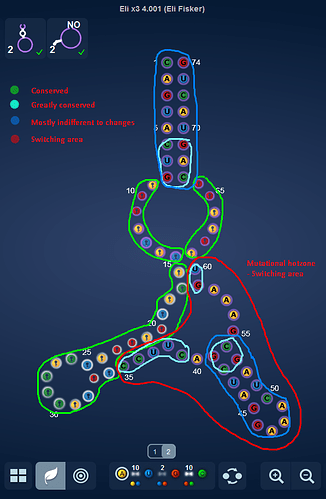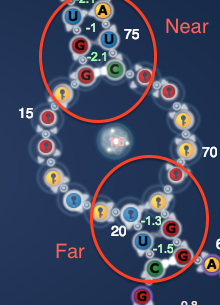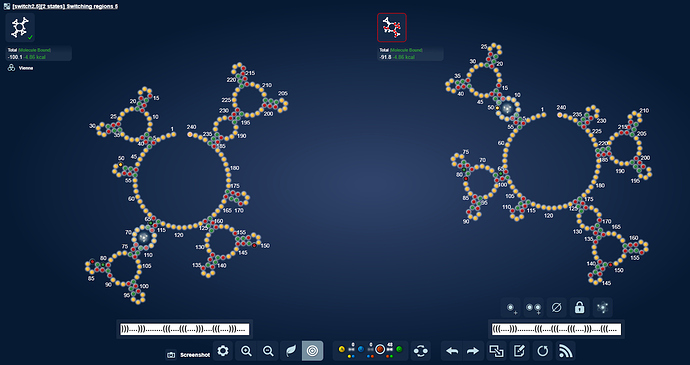What makes a RNA switch hard?
Practically the opposite of what works well for switch labs.  What works well there are repeat sequence and symmetry.
What works well there are repeat sequence and symmetry.
Things that makes for a hard switch
-
Asymmetry
-
Well varied sequence (Lack of repeat sequence)
-
Large shifts in structure between states (lack of shared structures between states)
-
Larger puzzles
-
More states (to a certain degree)
-
Many small and uneven length stems (simulation doesn’t care about them being too long to ever switch in real life)
-
Many varied sizes of elements. (That be internal loops, bulges, smaller loops in particular and multiloops too)
This is a hard RNA switch
What will make a real hard switch puzzle to solve, both for humans and bots (I suspect the later too for now) is asymmetry and greatly varied sequence.
Basically sequence that stems from a natural RNA should be a perfect candidate for a hard to switch puzzle or lab.  Probably same goes for structure.
Probably same goes for structure.
The perfect nightmare switch can be made out of a perfect static RNA design structure and sequence. Its asymmetric, it has varied elements size, varied stem lengths, varied elements and varied sequence all in all. Else it wouldn’t be a good static design.
All it takes to make a hellish switch of such a good static RNA sequence is just mutation points are randomly added to it and new target states are made into a switch. Especially if said static RNA is large. And the structure changes between the states are large. That simulation puzzle will be hard by default.
When structure is varied there are no equal regions for touch up and pairing. (Similar size of elements aids them pair up with each other.)
Example from a most beautiful puzzle Cynwulf created. Notice how the hairpin loop and the internal loop that are present in each of the repeat structures, are used for making two such shapes pair with each other for turnoff in that shape.
Despite it being symmetric, there is nothing easy about Cynwulfs large symmetrical switches.
Discussion, cryptography and trapdoors
I have been discussing hardness of switches with Omei. Here comes part of our discussion. Back then there were still no solvers of my switching snowflakes.
At first I thought that my snowflakes would also be hard to solve for humans. (The single state snowflake puzzles earlier were hard to bots, but not humans) Basically I was new to making them switch, so I didn’t had a feel yet. While not yet in huge numbers, players have caught up with most of them. Except for one of my 3 state snowflakes. They are not easy, but they are not impossible.
However none have yet solved my asymmetric switch monsters that were based on structure from a single state RNA puzzle. (IRES_VEGF_A: As nature never intended it) I didn’t even try with the original natural sequence. I don’t even know if the puzzle structure is 1:1 in size with the native structure. Just that the sequence from the solve itself which were varied a lot (not much repeat bases) seemed to be enough.
Tuesday 23 january
eli [3:01 PM]
Sending you a teaser puzzle made by my new method. It took me very little time doing so whereas I had struggled to make puzzles of those shapes I showed you and intended for the 4 state switch maker. They looked so easy to make, as I had their shape, but were trouble when I attempted to solve them. [Note: I was trying to make the misfold in the sequence by hand - it was easy sparking a new target shape, but harder to make a solve also when I had to pre-fit the whole sequence on both states.]
http://www.eternagame.org/web/puzzle/8567161/
eli [8:01 PM]
As I said, I have found a shortcut to make real sweet switches
eli [8:03 PM]
No one has solved yet. But me
omei [8:06 PM]
Hm. This may be a good model of a “trapdoor” function, essential to modern cryptography. It’s a function that is easy to compute, but computationally infeasible to invert, i.e. discover the input from the output.
eli [8:07 PM]
Yes, exactly. I was actually surprised how easy it was designing switches and make them stable, when I had first gotten help on cracking using the switch maker.
[8:07 PM] The hard thing is solving them after the fact. [From scratch]
Cynwulf had to greatly simplify a number of his switches for them to even have my interest attempting to solve. Cynwulf still has crazy switch making skills.
Friday january 26
Small intro that is related to the following discussion.
Cynwulf had put up a puzzle that morning that I think I worked around 1⁄2-1 hour on. I could only get one state stable. The puzzle shape was messy - aka not symmetric.
http://www.eternagame.org/web/puzzle/8570732/
It is long time since I have been so inspired by a puzzle I couldn’t solve.
The puzzle is called Tripping switch, for some reason it made me think of a Tripwire instead.
That said, I am getting more and more thankful for the consideration that Cynwulf shows in many of his complex switches, when he locks up a good part of the switch.
I decided I wanted to make a asymmetrical switch and went back and dug up some of our early challenge puzzles, that were inspired by real and mostly static RNA. After playing around with this and getting some puzzles up I talked with Omei.
eli [1:31 AM] Ok, it is getting bedtime here. But just wish to show you what I managed to make today:
eli [1:34 AM]
I borrowed the bird from Quasispecies, but I made it switch. 
The original puzzle was called Phoenix rising. And off with me. Wishing you a good day.
omei [2:18 AM]
Whoa! That’s probably the most artistic puzzle I have ever seen!
eli [11:13 AM]
Hehe. I liked the bird, and it had mirrored parts so I created complementarity between the wings with the sequence I put in. (edited)
I have been thinking about what you said about cryptography, trapdoors and snowflake switches. It turned out that people are able to solve them. Cynwulf must have heard my whisper about him being stalled as he took down several after. Malcolm seem to have a specific knack for them. I think it is not the symmetric puzzles that will be the hardest as the more [shared] shapes there are, the more it will lead back to the original sequence. Because of the symmetry puts a lock on how many possible solves there can be.
eli [11:33 AM]
Just like there are only very limited solves to Wwei23 extreme multistate puzzles. Where I think the trapdoor thing can be true is if one take a big asymmetric puzzle, make a mismatch somewhere and stabilize the new target. It will be hard afterwards to see where the change has been made. It will probably be easy to make, but hard to solve.
I haven’t tried that yet. But I suspect that it will take far longer solving. That could stand for a test. Me back to find some big natural asymmetric static RNA, and play with it. 
eli [11:50 AM]
I just did this with a monster of a puzzle. Took me about 5 minutes stabilizing after I had decided on which puzzle and where to put a mismatch. Unfortunately - and fortunately for the rest - this puzzle is way over the 400 base limit. But here is my proof:
eli [11:51 AM]
eli [11:52 AM]
I built it over this puzzle: http://www.eternagame.org/game/puzzle/259159/
eli [12:09 PM]
Because I already had the key - the knowledge of the original sequence for state 1 - plus the knowledge of which base pair[s] I changed in state 1 to get the shape of state 2 - it was fairly easy for me to iron out the small differences that needed to be changed to make the two states both agree with each other. (edited)
eli [5:58 PM]
Basically I’m saying that asymmetric switches will be harder to solve, the bigger and the more states there are.
I have a 3 state monster. Its an asymmetric switch and as ugly as it comes.
http://www.eternagame.org/web/puzzle/8571025/
eli [6:04 PM]
I think the asymmetric switches will be harder, exactly because they don’t share any common structure between the states.
Of cause they can be made share parts, as the sequence may form into similar structures. I however tried to avoid that with those I picked for the switch, as I suspect that would be easier to solve. 
[8:38 PM]
The more asymmetric the structure, but also the more varied the sequence, the harder the switch.
[8:39 PM]
Basically static rna sequences are perfect candidates for hard switches. 
Structure and sequence wise
omei [8:40 PM]
When you say hard switch, are you including both creation and solving?
eli [8:40 PM]
I mean more solving
[8:41 PM]
Creation is a bit harder when it is asymmetric, but not much. The hell to pay will be on the solver side. Your trap door thing.
omei [8:42 PM]
This does make sense.
eli [8:42 PM]
I still can’t say much about creation difference as yet I’m still rather new to them.
RNA switches, encryption and keys
Today I have been watching some Khan videos about RSA encryption (because they mentioned trap door). I think that the mutation points that I introduce in the ground structure (state1) that gives me a new target - are to be compared to prime factorization. Its a key part.
When one is given only the structure then one has no idea where these mutation points were made.
Thats except if it is a symmetric puzzle. Because then there will be repeat structure and repeat sequence. Repeat structure is also a kind of a key. Just a puzzle having 4 similar parts, is a enormous reduction of complexity.
Just having a section of a puzzle fold in a concerted way is already a reduction of complexity. Something I have gone into for lab switches in the post Christmas snakes.
Plus to create symmetric new targets, I typically place the mutation points in a symmetric manner. Just from the new state one will be able to say something about where these mutation points were more likely to be put. You have no chance of that with an asymmetric puzzle.
RNA encryption with Ribozyme Pistol
I am making a puzzle series that I will use to demonstrate this.
I have made 3 puzzles with up to 4 states. They were easy making. Took me around 5 minutes to stabilize each new state.
First I give the key to the ground state - a repeat of 4 sequences + a specified amount of A’s in between.
For each new state I make, I add 4 changed bases. Sometimes I only change 2, but since they both are in a pair, a pair are affected. So for 2 states there are 4 mutation points, 3 states, there are 8 mutation points, for 4 states, there are 12 mutation points. Each point affecting multiple other bases. Especially because the different states are entangled.
If one takes the sequence from the last puzzle with the most states and use together with the new target, one introduces less spots to stabilize.
The dot bracket structure of RNA can be thought off as a kind of the public part of a key. That in itself put some limits on what sequence is possible, because pairs have to be legal.
I will also put up a ground state of the mentioned puzzle series, as to help the realization that the key sequence alone can solve this. At last in the series I will give the encryption key. Where I lock just my mutation points. Then everything needed to solve the puzzle, is there. Else it will be a hard puzzle despite it has symmetry and is made from repeat sequence.
I will later make easier versions of some of my switch puzzle. For now I am testing my wings. Plus I need real feedback on what is hard or not. I can see that in the numbers of solvers.







































































